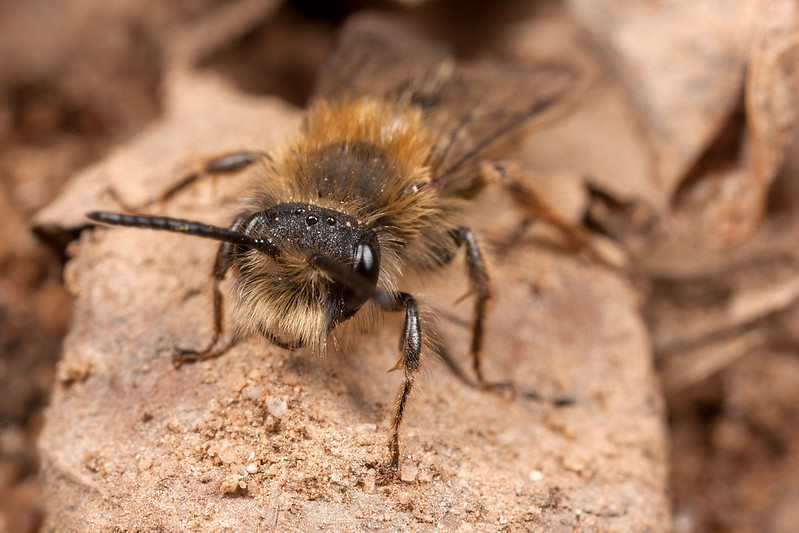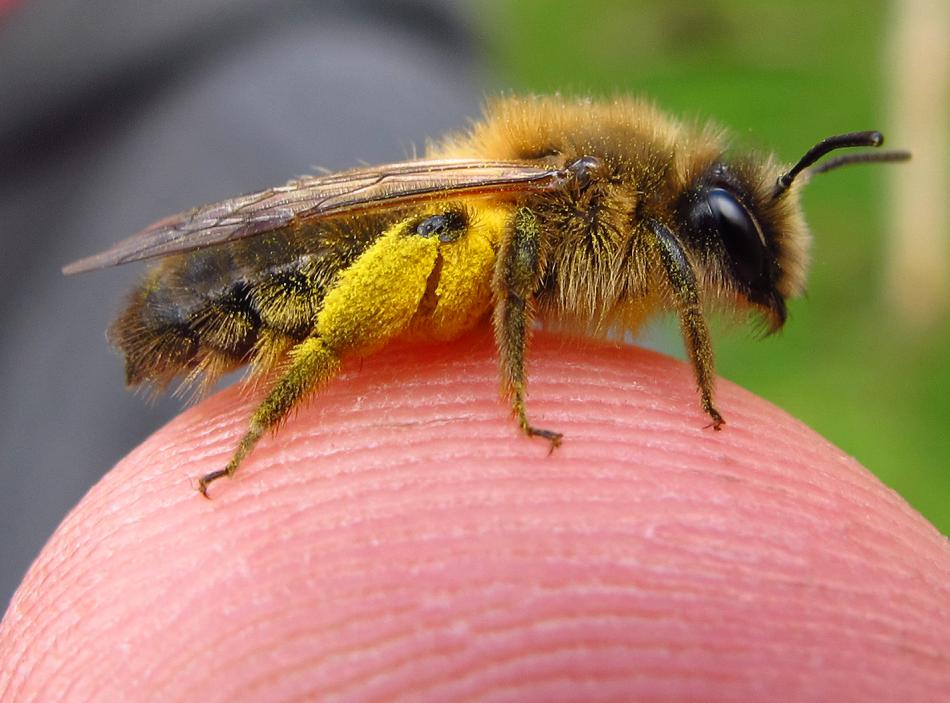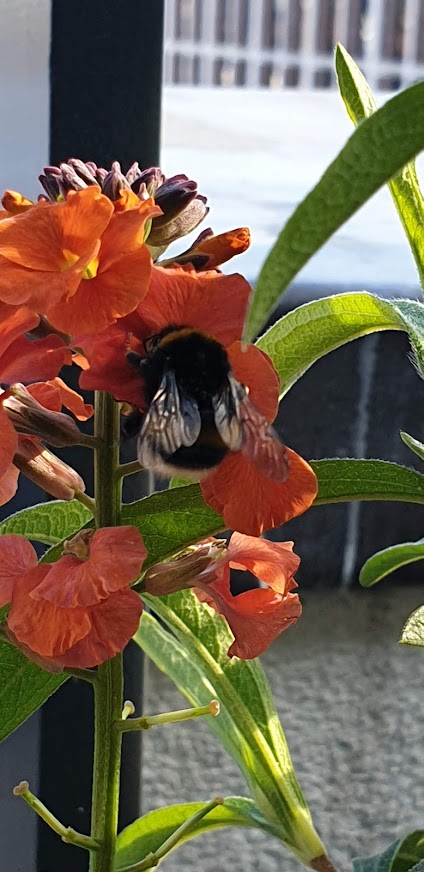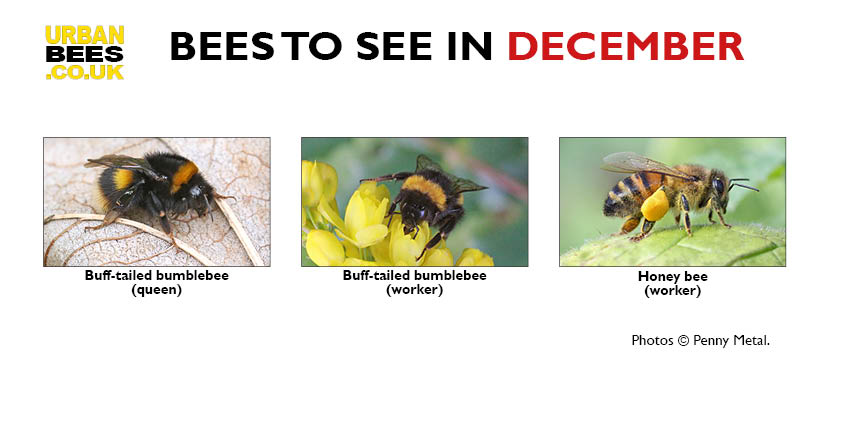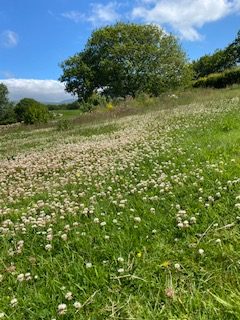
Pictured above are three bumblebee species around this month: Tree , Early and Red-tailed bumblebees. (In addition you may also see buff-tailed bumblebees which have been flying all year in some southern parts of the UK and Common carder bees (Bombus pascuorum) which are starting to emerge).
How to ID them:
- The Tree bumblebee (Bombus hypnorum) has a conspicuous ginger thorax, black abdomen and a white tail. Unlike other bumblebees, they live high up, often colonising bird boxes when the chicks have fledged.
- The Early bumblebee (Bombus pratorum) is smaller (up to 14mm) and prettier with her fluffy yellow collar and her noticeable orangey bottom. As her English name suggests, this is a spring specialist. The queens started to appear last month, followed by the female workers, and this month you may see both males and females. You can tell them apart because the males have much more yellow facial hair, like the one above.
- The huge, 17mm Red-tailed bumblebee (Bombus lapidarius) queens are one of our biggest bumblebees and without doubt one of the most striking with here black body and fiery red bottom. Although widespread, I’ve not seen one for a long time. The books say she is partial to blossom of sallow (willow) and prunus (cherries and plum) trees. I find the smaller, yellow-faced males are easier to see later in the summer.
Queen bumblebees may have nested (most underground in old rodent holes, under paving slabs, garden sheds, or even in compost bins) by now and laid their eggs, and some, like the Early bumblebee, may even have produced worker bees who are out collecting nectar and pollen to take home to their queen and her developing colony.
How to help them:
- Leave a patch of the garden wild for nesting sites and don’t disturb a nesting site if you find one (it will only last until the end of the summer).
- Put up a blue tit box for the tree bumblebee to nest in after the chicks have fledged.
- Plant dead-nettles, clover, forget- me-nots, and rosemary to provide food this month for the short-tongued bumblebees.
- Sow seeds inside now to create more flowers later in the summer. Sweet peas, sunflowers, cosmos and Anise hyssop are some of the easiest to grow. Try growing on a heated mat until the seeds germinate.
- Don’t mow the lawn (let clovers flower) and ditch the weed killers and pesticides.
- It’s still cold in the mornings or at night, or when the sun goes in, so bumblebees can get chilled and easily exhausted. The best way to help is a teaspoon of sugar, water solution. But please don’t feed them honey, it harbours bacteria that is bad for them.
These are the six most common solitary bee species this month: Buffish mining bee, Tawny mining bee, Orange-tailed mining bee (female), Red mason bee, Hairy-footed flower bees (male and female) and Gooden’s nomad.
How to ID them:
- The Buffish mining bee (Andrena nigroaenea) is around 10mm with a dense brown pile on the top of its thorax (just below it’s head). Look at the flowers on blossoming trees and shrubs such as fruit trees, willows, and blackthorn, and wildflowers like dandelions, hawk’s-beards, buttercups and spurges. If you see a bee that at first you may think is a honeybee, take a closer look. If it is a smaller. slimmer and browner, chances are it’s one of the many brown mining bees out at this time, of which the Buffish is one of the most common, along with Gwynne’s (Andrena bicolor) and the Short-fringed (Andrena dorsata) mining bee. Don’t worry if you can’t ID them, the fact that you are looking closely is good. The latter two have two generations in one season, so if you don’t spot them in the spring, you may see the next lot in late summer instead.
- The Tawny mining bee (Andrena fulva ) is easy to spot as she burrows up through lawns, her foxy-coloured coat strikingly visible against the green grass. And she leaves a tiny volcano-looking mound of soil in her wake. Like all mining bees, many will emerge from the same burrow or next door burrows in large aggregations.
- Orange-tailed mining bee (Andrena haemorrhoa) females have now emerged after the smaller, drabber males. The 10mm females should be easier to spot because of the neat brick-red pile on their thorax. Try looking for them foraging on tree fruits, dandelions and spurge. They will fly until July so don’t give up if you don’t see them this month. Like all mining bees, they burrow into the ground to nest, and they collect pollen on their hairs on their hind legs.
- Red mason bees will be checking out of bee hotels by chewing through the mud-plugged tubes. They are a little smaller (12mm) than a honey bee (14mm), more gingery and have a rounder bottom. The males appear a couple of weeks before the females and congregate around the bee hotels waiting to pounce when the females emerge.
- Hairy-footed flower bees (Anthophora plumipes) are often mistaken for bumblebees because of their round, fluffy appearance, but they live alone (not in colonies). At this time of year gangs of brown-coloured males are clearly visible chasing the more striking black females among the lungwort (pulmonaria), wallflowers and alkanet with their long, straw-like tongues (proboscis) outstretched. It is mating season.
- Gooden’s nomad bee (Nomada goodenianna) looks more like a common wasp, than a bee but it’s a cleptoparasite, or cuckoo bee. There are 34 Nomada species in the UK (850 worldwide), and this is one of the most common. She is much easier to ID than the small, brown mining bees which are her host. So if you see her, you know that the mining bees in the underground nest she is hovering around are either Grey-patched (Andrena nitida) or Buffish mining bees(Andrena nigroaenea). So lots of Gooden’s nomad bees, means the host bees, whose home they break into and lay their eggs, are alive and healthy. (Worldwide, a quarter of the 20,000 recorded bee species are cuckoos).
TIP How do you to tell a Gooden’s and a wasp apart? Gooden’s are usually flying low looking for the nest of a mining bee or even walking around on the ground. And they won’t bother you.
How to help solitary bees:
- Plant lungwort, wallflowers, comfrey and flowering currants for long-tongued hairy footed flower bees. Flowering fruit trees, willows, spurges, alkanet and forget-me-nots for red mason bees, and mining bees.
- Leave old mortar untouched as hairy-footed flower bees may be nesting here. Or make some cob bricks that they can nest in instead.
- Install bee-hotels in a warm location at least a metre off the ground, ideally facing south, where red mason bees can check-in and lay their eggs. We like to use these type of bee hotels with the cardboard tubes. You can take the cocoons out of in the winter and clean them.
- Leave a patch of loose, bare earth for mining bees to burrow and where red mason bees can collect soil to plug their nests.
- Create a bank of sand or a mound of sand in a sunny spot for mining bees to nest in.
- Let dandelions and alkanet grow – they are important early bee food.
For information on the honey bee (Apis mellifera) and the bee-fly (Bombylius major) see Bees to See in March blog here.



